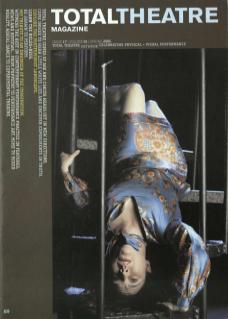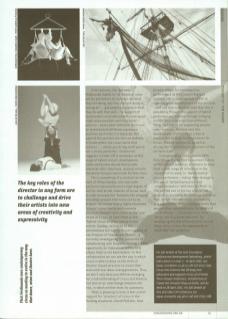Over the last twenty years circus has experienced a period of reinvention and reinvestigation, resulting in a widening range of working practices. We are in a situation where circus can be identified as inhabiting three broad styles: 'classic’ circus, 'new' circus, and a 'hybrid' circus. Whereas classic and new circus both rely on the pre-eminence of a skill-centred approach, revelling in the miraculous achievements of the human body in space and time, hybrid circus introduces theatrical and/or dance ideologies so that the skills of circus are used to deliver a narrative, concept or issue. It is primarily in this context that the idea of a 'director for circus' is emerging.
There are a variety of ways that artists have discovered this role of 'director', often emerging out of their interests in the kind of work they wish to pursue and a varied experiential base in a variety of performing arts. This changing approach to making circus-based work has been supported by the Circelation project, a series of workshops and mentoring programmes designed to provide both training for circus directors and the opportunity for circus-performers to work with directors coming from other disciplines. Circelation's two-year pilot phase (2000-2001), programmed by Chenine Bhathena and Leila Jancovitch, explored key aspects of circus work through short courses and mentoring programmes. Guest teachers included Katherine Hunter (Theatre de Complicite), Gail Kelly (Legs on the Wall) and Ron Bunzl (Cloud Chamber) who ran workshops and mentored emerging artists over the two years. Hunter went on to direct Mamaloucos' co-production with the National Theatre of Aristophanes' The Birds, bringing circus skills back into the foreground of the subsidised arts.
In April 2004, Circelation began a new three-year phase of training for performers and directors. The 2004 Circelation programme was devised by Dick McCaw (director of the International Workshop Festival 1993-2001). In this he aimed to 'broaden horizons' as to what circus could be. The support for new directors in this programme took the form of mentoring by Rose English and Mladen Materic. Directors were given an opportunity to 'doubt, dare and fail'. Daniela Essart of Scarabeus saw this as a unique opportunity to work with other directors within a 'safe ground'. Working with Materic and feeling confident in her ability to produce strong visual images, Essart aimed to develop her approach to structuring performance. She found that one of the most valuable things she acquired was the need to become stricter about a show's 'logic', by anticipating the questions an audience might ask of the show.
Circelation also proved particularly fruitful for Tina Carter of Expressive Feat Productions, who is currently exploring work around political issues emerging out of her Middle-Eastern heritage and working with Rose English on a forthcoming performance entitled Boxing Palestine. During Circelation, Carter was able to experiment with the interaction between circus, dance and live art, devising new material that has fed into the process of exploring the emotional and political dimensions of the Palestinian-Israel divide through the development of emotional and narrative stage action. Carter is a director for whom circus skills become the vocabulary for a narrative dance in vertical and horizontal space. In reflecting on her work, Carter identified the need to make three key considerations in the creation of work: aesthetic, narrative and practical. That is, to consider how work looks, how it communicates the narrative, and what needs to be in place to allow a specific trick to take place. Carter has also discovered an increasing need to write-up the material, both as planning and record. Carter finds the focus and logic that evolves from this invaluable in justifying the work in terms of the narrative and practical logic of a piece of work.
In terms of the exploration of narrative and character, the work of Company FZ serves as an interesting example of the way in which theatrical narrative may utilise circus skills. Flick Ferdinando, one half of the FZ team, approaches the task using a 'conventional theatrical approach, beginning with the expressive qualities needed for performance and then applying appropriate and relevant circus skills. Ferdinando identifies a variety of issues arising out of this approach, primarily because of the nature and impact of circus training on the performer's approach. Ferdinando identifies a proclivity within circus to focus upon ‘the trick', a preoccupation that emerges from the nature of circus training, one that involves a continual investment of time and energy in achieving a more difficult trick than before. This leads the focus of performance away from the expressive qualities of the performer to one that favours the physical skill involved; leading to performances that are visually rewarding, but for Ferdinando too 'clever' and lacking in expressive quality. She sees contemporary Circus as needing to 'evolve' in the way that dance, mime and theatre have. Ferdinando's approach signals a clearly thought out rationale for a specific direction in which circus skills are moving, and this is reflected in the training currently on offer at contemporary circus training schools The Circus Space and Circomedia.
In her process, the demands Ferdinando makes in the rehearsal room are for performers to consider not what they are doing, but how they are doing it, aiming to get people to question what they do with that skill... In support of Ferdinando's attitude towards training we might draw parallels with Grotowski's plastics where each technical skill must be invested with different expressive qualities each time it is explored. But against this process she sees an endemic attitude within the circus world that believes... unless you do big stuff you're not a circus performer. Ferdinando suggests a trade-off is necessary at this stage of hybrid circus' development, where performers should devise with whatever skills they have, and put on hold the desire to learn new tricks for that show.
This is something of a contrast to the work of Philip Gandey, who sees both performer personality and a high degree of skill as vital to the creation of circus-work in order to avoid the fantastically wrapped Christmas present that turns out to be ‘broken'. He comes from a highly renowned ‘classic' circus family and currently positions himself much closer to the 'new' circus of Cirque du Soleil than to the ‘hybrid' circus of other artists in this article. Gandey, attracted to the spontaneous but tightly structured work of Lee Simpson of Improbable Theatre, is currently investigating the possibility of collaborating with Simpson, looking for the opportunity to take circus artists to ‘places they've not been before'. In this collaboration we can see the way in which circus is able to draw on the skills of theatre-based directors to invest their work with new ideas and approaches. Thus, we don't only have possibilities emerging for a hybrid blending of circus and theatre, but also of an interchange between the two, in which neither loses its autonomy.
What is pleasing to note is the current support for ‘directors' of circus in the funding structures. David Micklem, lead theatre officer for contemporary performance at Arts Council England national office, sees the role of ACE in supporting the development of the artform and one way in which he sees that this is possible is through the support of hybrid performances, whether through bringing established companies from different fields together or for supporting smaller scale ventures. Micklem sees this development of a hybrid as a way to expand and develop audience bases for circus, theatre and dance, as well as driving forward the development of the artform itself.
In programming Circelation in 2004, Dick McCaw stated that he wanted to draw on the natural tendency of theatre to draw from a wide range of influences in the creation of its work; to 'dehabitualise' circus performers – taking them through a process of 'defamiliarisation’ and ‘refamiliarisation’ with their artform. In this we find one of the key roles of the director in any form: to challenge and drive their artists into new areas of creativity and expressivity. Philip Gandey asserts that people often underestimate the ability of circus artists: ‘they have a lot more ability, but it is never explored'. By developing the role of the director we can allow circus artists the opportunity to reach their full potential.
For full details of the next Circelation professional development laboratory, which takes place in Leeds 2 -15 April 2005, see www.circelation.co.uk
Circus Arts Forum is the UK body that advocates and supports Circus of all kinds. Their annual conference, entitled How to Create the Greatest Show on Earth, will be held on 28 April 2005. For full details of this and other CAF Initiatives see www.circusarts.org.uk


